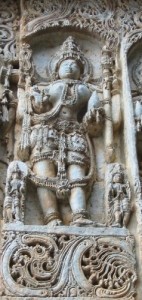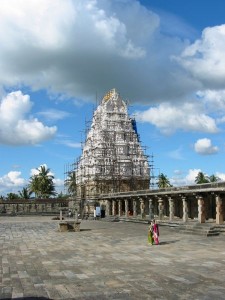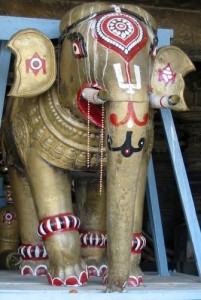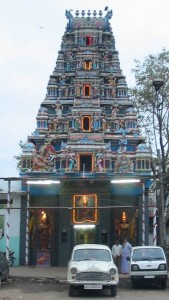Köln Hbf (ICE) – Creußen (RE) – Fahrplan 17.53 – 23.42 – Realzeit 18.10 – 23.44 (2 Minuten Verspätung)
(Wobei der ICE Lokführer die Verspätung bei der Abfahrt gut wieder rausgefahren hat, sonst hätten wir den Anschluß in Nürnberg verpaßt gehabt…)

Köln Hbf (ICE) – Creußen (RE) – Fahrplan 17.53 – 23.42 – Realzeit 18.10 – 23.44 (2 Minuten Verspätung)
(Wobei der ICE Lokführer die Verspätung bei der Abfahrt gut wieder rausgefahren hat, sonst hätten wir den Anschluß in Nürnberg verpaßt gehabt…)
 So ähnlich habe ich es zumindest in der Schule gelernt. In Indien leben Hindus und die Tempel sind bunt und farbenfroh, wie auch die Saris indischer Frauen.
So ähnlich habe ich es zumindest in der Schule gelernt. In Indien leben Hindus und die Tempel sind bunt und farbenfroh, wie auch die Saris indischer Frauen.
Das ist natürlich nicht falsch, aber auch nicht die ganze Wahrheit.
People in India are hindu, that’s what I learned at school. And their temples are as colourful as tha sarees of indian woman.
Of course that ist not wrong, but it’s not the whole truth either.
Es geht schon mal damit los, daß natürlich nicht alle Hindutempel quietschbunt sind. Oder zumindest nicht mehr quietschbunt… das erste Bild ist aus Halebid (der Ort hat noch mehr Schreibweisen als Tempelstatuen, will mir scheinen…) vom Hoysaleswara Tempel, der ab 1121 erbaut wurde. Wenn man bedenkt, daß er über und über mit fein ausgearbeiteten Statuen bedeckt ist und nicht außer acht läßt, daß all dies aus Stein ist, dann überrascht es vielleicht nicht, daß er auch in 80 Jahren Bauzeit nie fertig wurde. (Sagt zumindest der Lonley Planet, für mich sah es gar nicht so unfertig aus…)
First thing: they are not all colourfull. Or at least no longer. the first picture was taken in Halebed, showing a detail from the Hoysaleswara Temple that was built from 1121 on. Isn’t that detailled statue amazing? And the place is all over decorated with statues and reliefs like this. The guide says it’s not finished… well 80 years is maybe not so much time if you have to work your decoration in stone…
Natürlich weiß ich aus Büchern, daß die Religionen in Indien nicht immer friedlich zusammengelebt haben und es auch bis in die Neuzeit nicht immer tun.
Aber erlebt haben wir das Land in dieser Hinsicht als sehr friedlich.
Daß im Muslimischen Viertel von Bangalore zwei große Moscheen nebeneinander stehen erzeugt keinen Ärger, auch nicht am Freitag. Und dazwischen ist mühelos Platz für einen kleinen Hindutempel… Die Kirche hingegen ist gerade mal eine Straße weiter.
Of course I have been reading books about history and I know, that people of different religions have not always been living together happily and peacefully in Indian history. And that problems are not restricted to long ago periods in history.
But we didn’t see any religous troubles while we were there.
 It’s no problem to walk around in the muslim quarter of Bangalore on a Friday afternoon. No problem that there are two big mosques next to each other. And there is still enough room for a small hindu temple between them. In the neighbourhood of the church in the next street.
It’s no problem to walk around in the muslim quarter of Bangalore on a Friday afternoon. No problem that there are two big mosques next to each other. And there is still enough room for a small hindu temple between them. In the neighbourhood of the church in the next street.
In der Nähe von Halebid (wobei 16km auf indischen Straßen lang sein können…) Ist Belur. Gleiche Epoche, etwa 100 Jahre Bauzeit und einfach riesig.
Das Bild zeigt sozusagen den “Haupteingang” (eingerüstet) und einen kleinen Teil des Hofes. Nicht sichtbar sind auch die weiteren Tempel die auf dem Areal noch stehen… und alles ohne Maschinen.
Die Reinigungsarbeiten am Portal wurden übrigens auch manuell durchgeführt. Hände und Sandpapier… nichts von wegen Kärcher oder so…
Close to Halebid is Belur (well, 16km on an indian street can be a looong journey…). Dating from the same time, took around 100 years to build and it’s huge.
The picture shows what I take for the main entrance (scaffolded) and a small part of the areal. It doesn’t show the other temples on that areal, there are several ones and they hat no machines to build them.
The cleansing of the main entrance was also done by hand and sandpaper… no Kärcher or another tool.
Während unseres Aufenthaltes in Indien fand ein wichtiges Fest statt: Diwali. Die Art der Feierlichkeiten erinnert ein wenig an Weihnachten und Sylvester zusammen:
Es werden kleine Öllichter aus Ton aufgestellt (heute auch gerne elektrische Glührbirnen…) und (Sylvester)Kracher losgelassen.
Gläubige Hindus gehen an bestimmten Tagen in den Tempel und bringen pujas (Opfergaben) dar.
Außerdem kaufen viele Familien neue Festkleidung, man trifft sich im Kreise der Familie und ißt. Besonders Süßigkeiten. (Süßigkeiten sind extrem wichtig bei indischen Feiern!) Meist zu viel.
Klingt bekannt, oder? 😉
Und die Gelegenheit zum Familienfest wird von allen gerne genutzt, egal welcher Religion und ob sie praktizierende Hindus sind oder nicht.
 Oh… und der Tempel in Belur ist nicht nur ein historisches Monument, er ist auch als Kultstätte noch in Benutzung. (Generell scheinen Hindus ganz wenig Probleme damit zu haben, einen Tempel als Touristen zu besuchen, sich aber auch noch schnell einen Segen abzuholen.)
Oh… und der Tempel in Belur ist nicht nur ein historisches Monument, er ist auch als Kultstätte noch in Benutzung. (Generell scheinen Hindus ganz wenig Probleme damit zu haben, einen Tempel als Touristen zu besuchen, sich aber auch noch schnell einen Segen abzuholen.)
Daher stehen einige neuere Wagen und Figuren herum, die offensichtlich bei Prozessionen herausgeholt werden.
Belur is more than a historic monument, the temple is still in use. (I got the impression that for hindus it’s nor problem to visit a place as a tourist, but getting themselves a blessing, too while going by.)
So they have also more recent wooden chariots and figures that are brought out for processions. (At least I think so.)
We were lucky to be in India while a majour religous feast was going on: Diwali. The way it is celebrated is a bit like christmas and new years eve on the same day:
Houses and streets are decorated with tiny earthen oillamps (oil may be replaced by small electric lightbulbs…) and they are burning crackers.
Lot of hindus go to a temple of their favourite god and do “pujas” (offerings).
Many families see it as a possibility to buy new clothes (expensive sarees, if they can afford it) then they come together and have big meals. And eat a lot of sweets. (Sweets are like the most important thing on an indian feast!). And usually everybody eats way to much.
Sounds familiar? 😉
Of course also non-hindu families like to use the occasion of the Diwali-holiday for gathering and having big meals…
 Aber um dem Klischee genüge zu tun:
Aber um dem Klischee genüge zu tun:
Hier auch noch ein Bild von einem ganz normalen Tempel, wie sie wirklich an beinahe jeder Straßen finden kann.
Dieser hier steht in der Nähe des Busbahnhofes von Bangalore.
Vor Kitsch und ein bißchen elektrischer Beleuchtung hat hier keiner Furcht, erlaubt ist, was auffällt. Oder so.
Angesichts des indischen Verkehrs, so meine Vermutung, wird ein Segen vor einer Reise besonders gerne genommen und dann reicht das Tempelbudget auch für elektrische Leuchtschläuche… (die sind nämlich etwas, was ich nicht an allzuvielen Tempeln gesehen habe).
Of course the “typical” colourfull hindu temple exists also. And they are really everywhere, smaller, bigger, just between normal houses in any street.
And they are not the least bit afraid of kitsch, colours and electric light wires if they can afford it.
The last picture was taken in Bangalore, close to the big Bus station.
Considering the traffic situation in India I suppose that everybody welcomes a big blessing before going to the coach. So the temple seems to have enough money for electric light wires… (something I haven’t seen on to many other temples).
(Btw: Anybody reading the English stuff? If nobody is interested I can restrict my english blogging on the sewing topics…?)